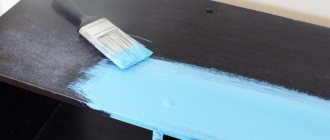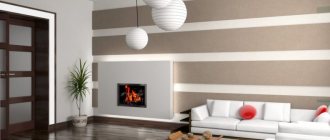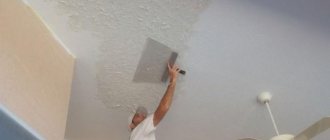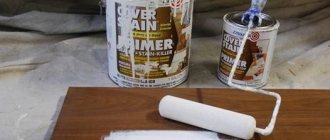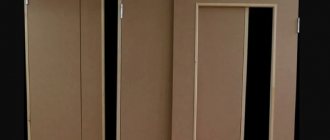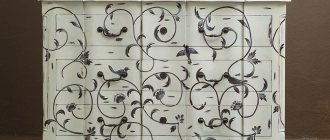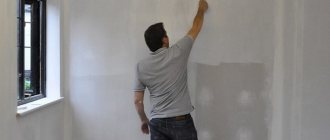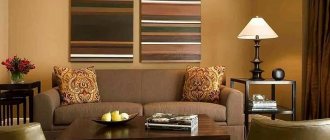assets/from_origin/upload/resize_cache/iblock/bbf/600_450_2/bbf14dc08d3c8f8402415a0b0b79c0b9.jpg From this article you will learn:
- What is the procedure for preparing walls for painting?
- How to remove old coatings when preparing walls for painting
- How to putty and prime the walls in preparation for painting
If the wall surface does not require additional leveling manipulations, then we can say with confidence that preparing the walls for painting will be an easy task. This work is the easiest step in renovating a room. Below you will find detailed information on how to properly prepare walls for painting.
Preparing walls for painting: work order
To achieve a positive result when applying the final coating, it is imperative to bring the surfaces themselves to the desired condition. It is important to strictly follow the steps of preparing walls for painting. Sometimes it is more difficult to properly prepare the surface than to cover it with paint, especially if additional leveling work is required.
The technology for preparing walls for painting is as follows:
- If there is an old coating, the surface is cleaned. To avoid problems during painting and visual defects after repairs, you need to clean the old coating (wallpaper, old paint, etc.) as thoroughly as possible.
- After cleaning, putty is applied. Puttying removes all defects and small irregularities on the surface. Usually 1-2 layers of putty are enough.
- Next, the walls are primed. Thanks to the primer, the paint will lay down in a more even layer. In addition, priming improves the adhesion of the surface to the paint.
- Sometimes it is necessary to treat the surface with special antibacterial drugs and agents against mold and mildew, this is especially true when preparing bathroom walls for painting.
Take the test
It is important to have the necessary set of tools that will be required for high-quality preparation for painting.
Sometimes certain tools may be additionally required, but the basic list is as follows:
- A drill with a special attachment necessary for removing plaster coating.
- A sanding machine or a block with sandpaper for carefully leveling walls and eliminating small defects.
- Vacuum cleaner for collecting dust after cleaning and sanding work.
- A construction hairdryer, a drill with a wire brush, a spatula and special compounds for removing old paint.
- A wide spatula and water (it’s easier to use from a spray bottle) will help get rid of old wallpaper.
- Special rollers and brushes are necessary for priming and puttying, for convenient application of materials to walls.
Selecting paint type
The walls have been prepared for wallpaper for painting, now we need to choose a paint. In construction stores you can find several types of paint, differing in both characteristics and composition.
As a rule, all this is indicated on the packaging and you just need to carefully read the available information; the information received can become the basis for choosing the type of paint and its use in certain conditions. Instructions are on each package.
They are also called water-based paints, since the main solvent is ordinary water. In this regard, they are also environmentally friendly, which means that they can be used in non-residential and residential premises.
They are widely used due to their low cost, ease of application and high-quality painted surfaces.
- Both during application and during operation, such paints do not emit harmful substances.
- Paints are produced in plastic buckets of various sizes, with a basic white color. To get a surface of a different color, just add a certain amount of dye to the paint, which can be purchased at the same hardware store.
- Surfaces painted with water-based paint can be wiped with a dry or wet cloth, as you can read on the packaging.
The basis of acrylic paints is acrylic resin. It provides high-quality coating of building surfaces and forms a smooth surface layer.
- Surfaces painted with acrylic paints can “breathe” and can be washed, but how active you can find out on the packaging.
- They can be used to cover fiberglass wallpaper, concrete surfaces, wooden surfaces, plastered surfaces, etc.
- The structure of the paint is such that it allows you to hide small flaws.
The main filler of such paints is latex rubber, which results in a very smooth and high-quality surface.
- Despite their vapor permeability, such paints can be washed regularly, as they are more resistant to washing than acrylic ones.
- They are able to maintain color for 8 years. The durable and moisture-resistant surface allows the use of latex paints in areas such as the kitchen, bathroom, corridor, etc.
- It is especially recommended to use it in areas of rapid contamination.
After application, they form a smooth, vapor-permeable surface that quickly gets dirty, but at the same time, it is easy to clean. Such paints are recommended for use in places or rooms where there is high humidity. Such premises include: bathrooms, laundries, kitchens, basements, toilets, etc.
Such paints can be considered more universal, as they have the characteristics of several types of paints. Latex-acrylic ones are very popular.
- When using, one should take into account the fact that they are vapor permeable, although they form a smooth surface that is resistant to moisture and mechanical stress.
- Such paints can withstand intensive washing, which makes them suitable for use in kitchens and bathrooms.
https://youtube.com/watch?v=c-WnBpLTbs8
Initial preparation of walls for painting - removing wallpaper
The first thing you need to do before preparing the walls for painting is to remove all pieces of furniture that interfere with the renovation from the room. A polyethylene film should be spread on the floor. This way, you won't have to clean up after finishing the preparatory work. To ensure safety during work, you must first turn off the power to all sockets and switches in the room.
Depending on the type of wallpaper and the availability of the necessary tools, the optimal methods for dismantling the old coating are selected.
Typically, the process of removing wallpaper from a surface is as follows:
- The entire surface with old paper wallpaper is moistened with water (preferably warm). If the wallpaper is vinyl, you need to pre-treat the surface with a needle roller. This way, the water will quickly saturate the wallpaper and begin to dissolve the glue. For ease of application of water, use a spray bottle. You can add a little vinegar or fabric softener to the water; they speed up the process of dissolving the glue under the wallpaper. It is necessary to achieve complete wetting of the wallpaper.
- Next, a special metal spatula with a rigid spatula is used. They carefully pry up the wallpaper and separate it from the base. You should try to remove as large a piece as possible at one time. If the wallpaper is difficult to peel off, you need to moisten the surface with water again. After removing the main part of the coating, the remaining individual elements of the canvas are cleaned with a spatula.
- Using a dry cloth, remove dried glue.
There are special tools that speed up the work of removing old wallpaper. When purchasing them, follow the instructions on the package, and you can easily get rid of the old coating, removing it in whole fragments.
How to remove whitewash when preparing walls for painting
Whitewashed walls should be cleaned before painting, that is, all old whitewash must first be removed.
Removing old whitewash can be done in several ways:
- By wetting. Using a spray bottle, the entire surface of the whitewashed wall is generously wetted. It is necessary to achieve swelling of the lime. First, the entire area is wetted, then individual areas immediately before removal with a spatula.
- Dry method. This method takes longer than removing whitewash using wetting. In addition, while working, you must wear a respiratory mask and safety glasses to protect yourself from inhaling dust harmful to your health.
- Using a sander. When working with a sander, it is advisable to have a construction vacuum cleaner with you in order to simultaneously remove the resulting dirt, otherwise you will have to spend time cleaning after finishing removing the whitewash.
- Using a special solution. You can make a special solution yourself using laundry soap and baking soda, or buy a ready-made mixture in a store. The surface is moistened with this solution, then the whitewash is removed using a spatula or a metal brush.
Important! Remember to take precautions and use special gloves, masks and safety glasses while working.
Removing ceramic tiles when preparing walls for painting
The method for removing ceramic tiles directly depends on whether you need to keep the old tiles intact or whether they are not intended to be reused. If the tile is of high quality and has a decent appearance, it can be reused for cladding a balcony or rooms in a country house. This is a great way to save on materials.
If the coating will not be reused for cladding, a simpler method of removing tiles by breaking them is used. In this case, the base under the tile remains as undamaged as possible.
The method for removing old tiles is selected taking into account:
- adhesive solution on which the tile was installed;
- the possibility of reusing old coating.
If cement was used when laying the tiles and the seams were rubbed with it, then during dismantling it will most likely not be possible to leave the entire tile intact.
It is important to use gloves to protect yourself from injuries and cuts from broken tiles.
First of all, you need to remove the grout from the joints between the tiles. This is done if there is a need to preserve the integrity of the old coating in order to reuse it in the future.
- To begin with, the seams are moistened with water, then they begin to remove the grout using a spatula or knife. If necessary, the seams are wetted several times until there is no material left in the gaps. But this method is suitable for removing only soft grout.
- Next, remove the remaining solution with a metal spatula.
- Next, select one of the top tiles and break it with a hammer and chisel.
- The next step will be to carefully clean all the seams between the tile elements, without damaging the tile.
- To avoid chipping at the corners, you need to make sure that the cut between the tiles goes deeper than the height of the tile itself. It should be repeated once again that if cement mortar is used during installation, there is almost no chance of keeping the tile intact when dismantling it.
- Next, all the tiles are removed from the surface one by one using a metal spatula or a thin chisel.
- The spatula is inserted under the edge of the tile and gently but firmly hit with a hammer.
- Next, move the spatula to the other edge and continue tapping. In this way, the tiles are removed from the surface from top to bottom. Having removed one vertical row, proceed to the next one.
- You can also use a special steel wire hook if the tiles are not firmly attached to the base. For this method, you need to carefully remove all the grout between the seams so that you can insert the hooks under the tiles.
- Using steel wire, the tile is removed in the following way: its bent end is inserted under the tile from different sides and pulled slowly. The tile should make a clicking sound when it is successfully removed from the wall.
- If the surface is plasterboard, then the tile can be removed only if one or more parts are replaced.
Remains of the adhesive solution from the tile itself should be removed with caution, because in this case, if handled carelessly, the danger of splitting the tile increases.
Recommended articles on this topic:
- Correct painting of walls
- Stages of renovation in an apartment
- Turnkey cosmetic repairs
Using a hammer drill to remove tiles is advisable in rooms where noise and large amounts of dust will not disturb anyone. The device is connected, the attachment (chisel) is inserted into the spaces between the tiles. The tiles can be easily removed, but all the tiles will be broken. But with this method you can quickly obtain a high-quality surface.
You can also use a chisel and hammer to remove old tiles:
- A chisel is placed under the edge of the tile, and the chisel is hit hard with a hammer.
- Use a chisel to separate a piece of tile from the base.
- With this method, the tiles crack, break off and are partially removed in pieces.
After all the tiles have been removed, a fan heater is used (50 mm is the optimal distance between the fan heater and the wall) to soften the remaining adhesive. After this, the solution is removed using a scraper.
Checking the evenness of the walls and choosing a method for eliminating identified deviations
When the surface repairs are completed, they should be checked for spatial deformations and unevenness to determine which final leveling method is best to choose. To carry out such an audit, you will need a building level and plumb line.
Before finally putting the wall surfaces in order, you should figure out whether there is a need for their large-scale leveling
These tools are applied to the surface of the wall (directly or through a long rule), and all its differences are traced. If the level differences exceed 5 mm, it is recommended to completely level the wall. Minor irregularities of 2÷3 mm can be leveled by applying a thin layer of plaster or putty mixture.
In addition, if you want to not only level, but also partially insulate and soundproof the walls, you can use plasterboard sheets, securing them to the wall with a gypsum-based adhesive. You can also attach this material to a frame sheathing, but in this case it should be taken into account that the size of the room will decrease on each side by at least 50 mm, and in cramped city apartments this is a very noticeable loss of space.
How to remove old paint to prepare walls for painting
There are two ways to remove the previous layer of paint: mechanical (using tools) and chemical (using special stripping solutions).
Below are the most popular methods:
- An effective, but time-consuming and labor-intensive way to remove old paint is to use a drill with a metal brush attachment. Use a drill to remove the coating in one or two layers of paint.
- You can melt it with a fan heater and then remove the old layer of paint with a spatula.
- There are also washes - these are special solutions that are applied in a thin layer to the surface using a roller or brush. Interacting with the paint, the solution softens it. Next, you need to work with a spatula to easily remove the coating. It is important to avoid contact of the solution with the eyes and exposed skin.
Removing Old Finish
If the wall that is supposed to be painted previously had finishing, then it must be removed. In addition, decorative items, lighting fixtures, and shelves are removed.
Wallpaper
Paper-based wallpapers are easier to remove. By pulling the tip of the sheet you can sometimes remove the entire sheet. If this does not work, then moisten the wallpaper with warm water. After this, they pry it off with a spatula and repeat the attempt to remove the entire strip.
To ensure that vinyl and non-woven wallpapers can be wetted, they are passed over them with a serrated roller or a stationery knife. After this, they are sprayed or moistened with a sponge. They are easily removed after treatment with a steamer.
Manufacturers offer compositions that are designed to make wallpaper removal easier.
Whitewash
It is difficult to remove whitewash. If it is not completely removed, the CM will not lie flat. Simple whitewash is washed off with a large amount of liquid. Another way is to use a spatula or sander. But this is a dusty way. An effective solution for removing whitewash is prepared quickly: for 10 liters of laundry soap liquid – 2 tbsp. l., soda - 5 tbsp. l.
The second recipe for the solution: for 5 liters of liquid, pharmaceutical ammonia, soda - 2 tbsp. l. dilute in 250 gr. water, shower gel, replaced with bath foam - 3.5 caps, vinegar 9% - 1 tbsp. l. The solution according to the second recipe is used warm. This causes the whitewash to swell and be removed with a spatula.
Dye
It is especially important to remove a layer of old paint if there is no clear understanding of what kind of composition it is. The new dye may not interact with the one already applied
For removal, special removers or tools are used (drill with an abrasive attachment, metal spatula and hair dryer).
Ceramic tiles
The ceramic is removed with the glue that holds it in place. A hammer drill with a chisel is used. After this, the walls are leveled.
Technology for leveling walls before painting
After complete cleaning of the surface, they begin to level it.
Leveling is additional work when preparing a wall for painting. It is only necessary when the unevenness is deeper than 0.2 cm and there are significant defects in the form of chips and cracks in the plaster. In other situations, you only need to sand the old plaster coating with sandpaper or a sander. More visible defects can be eliminated in the following ways:
- Applying plaster. First, the wall is cleaned of old plaster. A brush removes all dirt and dust generated during the work. After the dust settles, the surface is impregnated with a primer and wait until it dries completely. And only then do they begin to apply new plaster and level the surface using beacons.
- Finishing with plasterboard sheets. Using drywall you can quickly achieve a flat surface, but this method slightly reduces the area of the room.
After the leveling work has been completed, you can begin puttying.
How to get rid of serious defects?
Having removed the old coating, begin to prepare the walls, i.e. putty and prime them. But if there are serious defects (for example, deep cracks), fix them first.
If the crack is large and a small amount of putty cannot be repaired, then deepen and widen it (don’t be afraid, this is not a typo - this is necessary). Then clean the gap from dust, and then treat it thoroughly with a primer.
Such places on the wall must be sealed with plaster.
When the primer is dry, fill the gap. It is important to fill it completely with putty - this will ensure maximum adhesion and prevent cavities. In addition, glue reinforcing tape to the front part - press it into fresh putty, then apply the same, wait until it dries completely and sand.
How to properly putty when preparing walls for painting
It is advisable to always putty the surface before painting. Putty will prevent drywall or plaster walls from absorbing paint, since putty smoothes the porous surface of these materials. After puttying work, the paint is applied in an even layer without defects.
- First layer of putty
The first layer of coating is the starting putty, that is, a coarse mixture that allows you to hide large flaws in the form of grooves, holes and strong differences. The starting putty is applied to the entire surface or to its individual sections, depending on where there are irregularities. The coating layer reaches 15–20 mm. To hide deeper defects, putty is applied to a painting mesh.
- Putty for the second layer, or lighthouse
The second layer of putty is no different in composition from the starting mixture. The walls are leveled with this layer using beacons - smooth wooden or metal slats. The beacons are fixed on the wall and the second layer of putty begins to be applied. Alignment occurs in horizontal and vertical directions. Next, the level checks the quality of the resulting layer.
This step is optional if you managed to achieve a flat surface using a starting layer of putty. Also, the quality of leveling depends on the chosen finishing coating.
Starting putty containing fine sand can be applied with a thickness of 3-4 mm. Using a wide spatula made of a metal profile, small surface imperfections are leveled and smoothed out. The putty layer does not dry for long, so it must be diluted in parts immediately before application. You should also follow the instructions on the package and observe the proportions.
Using putty, you can achieve a strong, flat surface and stable adhesion of subsequent materials to the base.
To enhance strength and adhesion, it is advisable to use nylon mesh reinforcement when putting putty. A mesh with 2 mm cells is applied immediately to the freshly applied layer of putty, and another layer of putty is distributed on top of it.
The drying period of the putty lasts from 6 to 8 hours. After complete drying, the surface is sanded with sandpaper with P80 grain. Sanding allows you to get rid of visible imperfections in the coating, but after work the surface will be rough.
Types of painted surfaces
The surfaces that can be painted are very diverse. In the current options for creating an interior with your own hands, you can most often find the following:
- putty or decorative relief plaster;
- smooth plastered or putty wall;
- smooth surface: panels, wallpaper, tiles;
- surface with textured elements;
- wood.
Applying finishing putty
The final putty achieves the most even wall possible, ready for painting.
Using finishing putty, you can achieve a perfectly smooth surface, which will allow subsequent materials to lay smoothly without flaws. Since the starting layer contains sand in its composition, it gives a rough coating that is completely unsuitable for painting.
And the finishing layer of putty contains a filler of fine particles. Therefore, the solution easily fills the roughness of the rough layer and makes the surface smooth. Of course, finishing will require time and expense for quality materials. But the result of such preparation for painting will be a smooth surface on which the paint will lie in a perfectly even layer.
For the best quality coating, you need to mix the finishing putty solution as thoroughly as possible, breaking up all cement and sand lumps. Here you will need a construction mixer or a special attachment for a drill, and you also need a suitable container for diluting the solution.
By following the recommendations below, you will achieve a high-quality diluted material for finishing putty:
|
After using the next portion of putty, in order to avoid lumps of the old mortar getting into the new one, it is necessary to thoroughly rinse the mixing container, construction mixer or attachment for stirring the mortar.
The finished mixture for finishing putty just needs to be carefully stirred until all lumps are dissolved and a uniform texture is formed without compactions and solid particles.
When puttingty, you should adhere to the following rules:
- Dilute a small amount of the mixture. The putty dries quickly, and you may not have time to use it if there is a lot of solution.
- Calculate the amount of mixture needed for about an hour of puttying.
- Keep in mind that putty is usually applied in 2-4 layers to eliminate all surface defects.
- After puttying, the surface acquires strength, reliability and will serve you for many years.
- Remember that putty is applied only from the corner to the center of the surface.
Make sure the surface is completely dry after priming before applying a coat of finishing filler.
The technique of applying putty with a roller is quite simple provided that a number of conditions are met:
- provide the room with sufficient lighting, it is better to have several light sources;
- the solution must be non-solid;
- you need to roll the roller no more than half a meter at a time;
- It is best to work with a velor roller and tray;
- pour the mixture into a special tray;
- dip the roller into the tray, without shaking, apply the mixture to the surface;
- work can be carried out with a surface width of 3 m at the same time.
The spatula is also easily used for puttying walls. The principle of operation of the spatula is as follows:
- use a narrow spatula to scoop out the mixture;
- transfer the mixture onto a wide spatula (in a layer of about 3 cm);
- the spatula is brought to the surface at an acute angle of 30°;
- Apply a strip of putty about 30–40 cm at a time;
- excess material is removed using a narrow spatula and put back into the container with the solution;
- The action is repeated until the entire batch of solution is used.
The solution is applied with a spatula in lines that can be:
- straight;
- arcuate.
Please note that the finishing putty is applied in a layer no thicker than 2 mm.
After applying the putty, thoroughly sanding is carried out. High-quality sanding will prepare the walls for painting or applying other decorative coatings.
Grinding work is carried out using a special grinding mesh placed on a block. The mesh is bent along the contour and secured with clamps. The grinding technique involves the following steps:
- the surface is polished in a circular motion;
- the force of pressure on the block depends on the depth of the defect on the surface;
- Care must be taken to ensure that no indented areas are formed due to excessive pressure.
Tool
If you have not yet decided what to paint, then read the article about the choice and consumption of paint. We'll talk about everything else below.
For high-quality painting of walls with our own hands, we will need:
- Roller 25mm, 10cm
- A brush, or better yet two, 5cm
- Fishing rod, telescopic extension for roller
- Roller tray
- The bucket is empty
- Drill with whisk, mixer
- Covering film
- Masking tape 5cm
- Painting knife and blades
- Spotlight or any portable lighting device
- Acrylic sealant, gun for it
There is a tool for textured paint - these are textured rollers for painting walls and special brushes.
Which roller to paint walls with?
We choose a roller with an average pile of 1 cm, check with the seller so that the handle does not rust. I use rollers from HARDY - a budget option and ANZA - a professional tool. A roller for painting walls should not be made of foam rubber or cotton wool. I recommend choosing a roller for painting walls that is not the cheapest one. This roller is suitable for water-based paint and latex paint. For alkyd and oil, you need velor and preferably no longer than 20cm. But as I already wrote, walls are no longer painted with oil paint in modern renovations.


